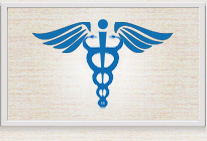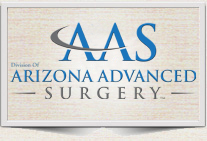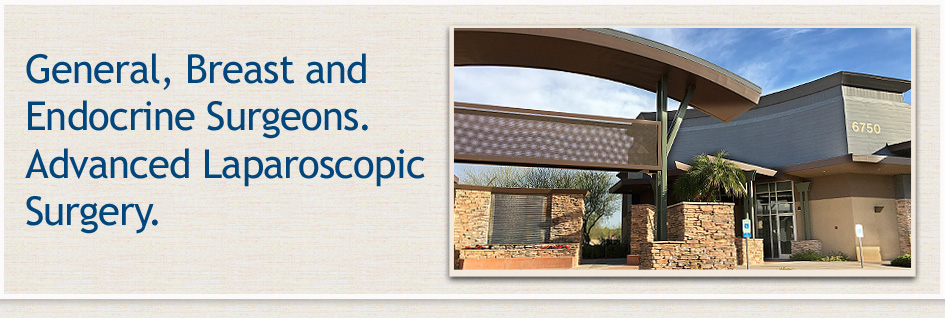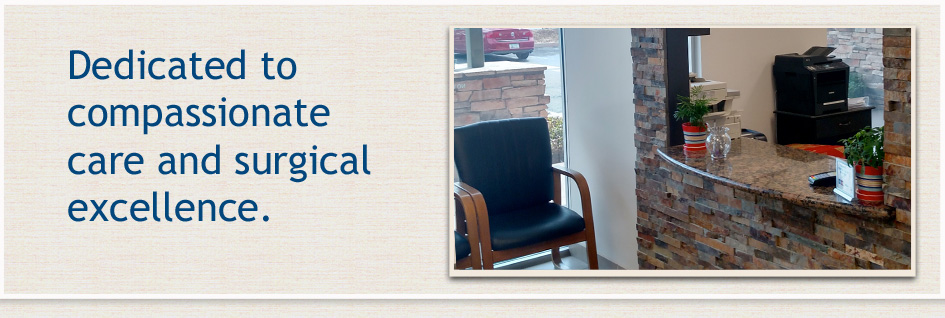Gastroesophageal Reflux Disease (GERD)
Gastroesophageal reflux is a condition that occurs because the muscle that connects the esophagus to the stomach fails to work correctly. When the muscle relaxes too much, acidic stomach juices rise up and irritate the lining of the esophagus. While occasional heartburn is common, persistent reflux that happens more than twice a week is considered to be gastroesophageal reflux disease and can eventually lead to more serious health problems.
When people cannot control their GERD with lifestyle changes and medication, many are helped by surgery. Doctors Allen A. Agapay and Jordan J. Glenn are experienced surgeons who provide minimally invasive medical procedures that bring relief from GERD with little pain and downtime.
Symptoms
- Frequent heartburn
- Feeling that food is stuck behind the breastbone
- Some people with GERD experience trouble swallowing
Diagnosis
Early detection is important to help prevent serious problems from developing. Your doctor may use one of these tools to diagnose whether you have GERD:
- Upper gastrointestinal endoscopy: A thin, flexible tube equipped with a tiny camera is gently inserted into the throat and is used to examine your esophagus and stomach. It helps your doctor identify if there is scarring from reflux, and if benign or malignant cells are present.
- X-rays: This non-invasive, painless procedure requires you to drink Barium, a liquid that coats the lining of your esophagus and stomach. The x-rays taken as the Barium passes through your body give your doctor a picture of the shape, condition and function of your esophagus, stomach and upper intestine (duodenum).
- pH monitoring examination: A thin, flexible tube equipped with a pH monitoring device is gently passed through your nose, into the esophagus. The device will measure and record acid levels over the next 24-48 hours while you follow your normal routine. You will be given a device to mark the times you do certain activities like eating, drinking and lying down. After the test is complete, your doctor will remove the tube and your results will be downloaded to a computer and analyzed.
Treatment
Doctors Agapay and Glenn perform laparoscopic and robotic procedures to treat GERD. These minimally invasive techniques provide quicker recovery, smaller scars, and less pain after surgery.
- Laparoscopic Nissen Fundoplication: Surgical Fundoplication is an operation to reinforce the malfunctioning valve between the esophagus and stomach. The surgeon uses an endoscope (a lighted video camera on the end of a flexible tube) that displays a magnified view of the patient's internal organs on a television screen. The surgeon wraps the upper portion of the stomach around the lower esophagus to reinforce the valve. Because this surgery only requires small (1/4 to 1/2 inch) incisions in the abdomen, recovery time and post-surgery pain are much reduced.
- Robotic-Assisted Nissen Fundoplication: With this procedure, your surgeon controls robotic arms holding instruments and a fiber-optic camera. The camera displays a magnified, high definition view from inside your body on a video monitor, and the robotics enables your doctor to have very precise surgical control while operating. Because the procedure is performed through tiny 1-2 cm incisions, recovery is quicker than through hand-manipulated laparoscopy.
Hiatal Hernia
Hiatal hernias are present in many (though not all) patients with GERD, and can aggravate symptoms of GERD. These hernias occur when part of the stomach pushes up through the hiatus (small opening in the diaphragm). Some hiatal hernias cause no symptoms, but large hernias of this type cause acid reflux, which can lead to erosion of the esophagus if left untreated.
Symptoms
Symptoms of large hiatal hernias include:
- Heartburn
- Burping
- Difficulty swallowing
- Chest or abdominal pain
- Feeling especially full after meals
- Nausea or vomiting
Diagnosis
- Upper gastrointestinal endoscopy: A thin, flexible tube equipped with a tiny camera is gently inserted into the throat and is used to examine your esophagus and stomach. It helps your doctor identify if there is scarring from reflux, and if benign or malignant cells are present.
- Esophagram: This non-invasive, painless procedure requires you to drink Barium, a liquid that coats the lining of your esophagus and stomach. The x-rays taken as the Barium passes through your body give your doctor a picture of the shape, condition and function of your esophagus, stomach and upper intestine (duodenum).
Treatment
During hiatal hernia surgery your surgeon may reinforce the malfunctioning valve between the esophagus and stomach, pull the stomach back down into place in your abdomen, and/or reduce the size of the hiatal opening.
An "open" surgery is performed through an incision in your chest wall or abdomen while you are under general anesthesia.
During laparoscopic surgery, your surgeon operates with a tiny camera and special surgical tools through small incisions in your abdomen. Robotic-assisted laparoscopic surgery is performed through small incisions while your doctor controls robotic arms holding instruments and a 3D camera. This provides the doctor with very precise control during surgery, often resulting in a quicker recovery time for the patient.
Hiatal hernias can be repaired with either open or laparoscopic surgery, including robotic-assisted laparoscopic surgery. Doctors Agapay and Glenn will determine the best option for your situation after careful examination.

Insurances We Accept
Click the "Learn More" link below for a full list of the insurance plans we accept. If you don’t see your plan on the list, or if you have any questions, please call us at 602-843-8317. Learn More

Arizona Advanced Surgery
Doctors Agapay and Glenn are proud to be a division of Arizona Advanced Surgery. Learn More



